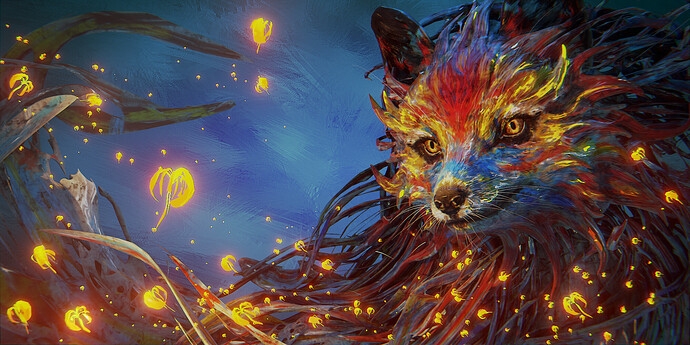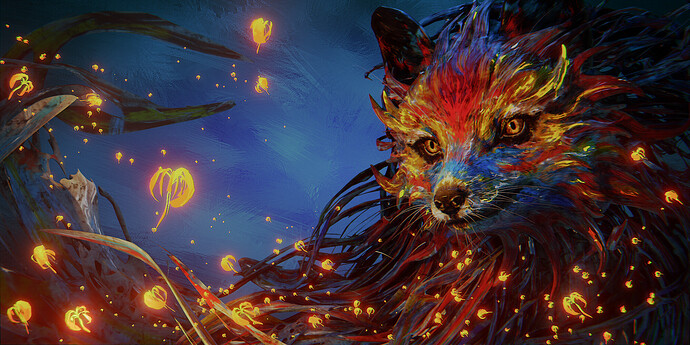I think I will leave that to ppl who know their stuff, just reading the terms “stanza” and “CDL” makes me want to run away as far as I can !
Ok looking into the file right now:
- !<ColorSpace>
name: Appearance Punchy sRGB
family: Appearances/Punchy
equalitygroup: ""
bitdepth: unknown
description: A punchy and more chroma laden look for sRGB displays
isdata: false
allocation: uniform
from_scene_reference: !<LookTransform> {src: Linear BT.709, dst: AgX Base, looks: AgX Punchy}
and
- !<Look>
name: AgX Punchy
process_space: AgX Base
description: A punchy and more chroma laden look
transform: !<CDLTransform> {power: [1.35, 1.35, 1.35], sat: 1.4}
Is it literally just a matter of changing this:
{power: [1.35, 1.35, 1.35], sat: 1.4}
to something else? If so, what might good values be to most closely resemble Filmic in terms of middle grey?
Yes this is where it defines what the punchy look does.
I have been trying to do that for the past couple of days, Troy gave a hint on how to do it, and I have succeeded in making it high contrast while keeping the middle grey.
The problem I am encountering is that I am doing the contrast in AgX Log, before the image formation. So I cannot boost up the saturation here. I need to do it in AgX base, after the image formation, but I am still wondering how to do both high contrast in log and high saturation in AgX base.
Basically this problem:
Troy said I can acheive it but I am not sure I understand his answer:
EDIT: I suddenly have thoughts on how to do this now, but my day job is not done yet, I will try my new idea out when I have time.
Ok I tried to simply make a Punchy with the power curve disabled (i.e. set to 1.00) and here is what I got:
- Filmic Medium
- Punchy 1.00
- Filmic Very High Contrast
- Punchy 1.35 (default)
It’s a decent chunk lighter and at least on this one test image I like it quite a bit. Would have to test more scenes. But on this one, it’s imo (subjectively) the best version of the image
This somewhat misses the point of the primary image formation step, I fear.
The point is to form the image with a reasonably dense amount of information. Where the ratios are present, yet compressed, it is rather trivial to push the signal out and stretch the chroma.
This is impossible to achieve when the information isn’t present, which in the case of Filmic is the case.
@kram10321 has already sorted out how to increase the chroma expansion uniformly. If one has a better tool, it is trivial to start with the base and expand out the desirable regions.
The trade off being of course that there is simply a limit. Keep pushing the values toward “more pure” representations, and the values skew and distort. Worse, it leads directly to fewer values, which is the wonderful world of posterization.
The general sensation of the appearance of chroma however, has less to do with jamming things out to the hull limit of the medium, and more to do with the relationship with other portions of the shot. Much like audio, loudness is not about slamming the audio limit, but rather contrasting against regions of quietness.
Does it mean the current punchy “look” already hit this limit ? and any efforts for pushing it any further is in “skewed territory” ?
Done! Success!
EDIT: May 23 Updated version:
EDIT:
There are more updates posted, go to the quoted post, I am not going to update this post anymore
I made the six contrasts + 1 base contrast for Punchy, and slipped in a custom creative grading Green Ink look I have been playing with (it’s just a byproduct of me experimenting with look transforms)
My modified AgX Punchy Medium High Contrast:
My custom Green Ink look:
Green Ink look’s creative intention is to have the shadow be dark green so it looks like some green ink dyed on those parts, and have the midtones be little warmer to bring out a bit more the orange color that I like so much.
A demo render for Green Ink:
Comparison with my modified Punchy High Contrast Look:
And also Compare with Filmic High Contrast:
Maybe you can try my modified config with some new looks here?
@troy_s Again I am not confident with my modification, maybe you can help me verify some of my changes.
AgX, as in silver halide?
I gave a shot at creating different variants of punchy through the Looks syntax in notepad.
config.ocio (10.0 KB)
Three contrast settings X three saturation settings + One high saturation Look for those really wanting an explosion in chromatic coloration. The looks are just adjusted CDL values (as I barely know anything else about the API).
Fantastic! I’m quite curious to try them out. Hopefully I can produce some demo images. I’d also like to play on my own, trying to come up with my own values, so seeing what you did will be quite instructive!
I have a question for you or anyone willing to answer regarding the use of looks for artistic purposes. What is the advantage of creating looks that are already skewed towards a certain element (I.e. your green ink config or Troy’s tongue-in-cheek sunshine) as opposed to creating these effects in post production?
Such changes would be quite easy to obtain in a later stage of the production. Moreover, keeping these changes for later would allow me to work with a wider, more “faithful” representation until the image to be post processed is created, which is intuitively what I would prefer as a workflow.
I am asking this not to say that such creation does not have a point, but because I’m genuinely curious about the artistic use of this possibility. If I’m not mistaken, @troy_s was hinting at the underestimated creative possibility that playing with “skewed”, artistic configs opens. But which possibility is it?
Was purely a demo that pushed the chroma outward on the attenuated signal. Nothing terribly analytic beyond looking for posterization and excessive greyness boundary crossing!
I will try to take a look during my down time this weekend!
Correct.
I’m not sure what “post production” entails here.
Generally, it’s worth considering the design and development of albedos and lighting in line with a general aesthetic one is going for, as the looks will ultimately influence how the efforts end up.
Working with a creative look is a feedback loop, and as such, the feedback will often guide the creative choices.
Not sure what your exact question is and use of the word “skewed” here. If you can flesh out your question, perhaps I can elaborate on a specific detail I was referring to.
Not sure what your exact question is and use of the word “skewed” here. If you can flesh out your question, perhaps I can elaborate on a specific detail I was referring to.
Pardon for the imprecision of my wording.
What would be the advantage of using a Look that tints the image in a specific way (i.e. sunshine with yellow; Eary’s green ink with green) as opposed to rendering an image that is overall balanced and then, after the image has been rendered, to apply a specific tinting to it according to one’s artistic necessities, in compositing or using any other processing software?
As I think about it, I realize that perhaps my question comes from following thought (and doubts): I had been thinking that, perhaps, an OCIO config is primarily a tool to ensure that a a certain way of representing colors is followed in a program/across different software. In general, I’d want to preserve the chroma as much as possible as I work and the colors to be represented in a predictable way. Hence why AgX appears to be an improvement over Filmic, as it doesn’t crush colors as much and allows clearer differentiation between hues, as proved in the above demos.
What part do Looks such as sunshine/green ink/any other possible look that artistically tints the image play here? Should Looks be used as a means by the artist to tint their image? What is the advantage in using a Look over, say, tinting the shadows using the compositor after the render has been generated?
Basically you are asking:
What can an OCIO look do that a bunch of nodes in the compositor can’t, especially when baking in some tint in the process (such as with Golden and Green Ink looks)
And if there is no difference in possibilities as such, why might it be better to work with OCIO looks than with equivalent compositor nodes
Dang suddenly a whole new collection of toys to play with
@Eary_Chow so if i see that right these are supposed to be used as Looks on top of AgX rather than on top of Punchy, right?
The more I look at this file format the more it looks to me like there totally could be an OCIO profile node editor. Or perhaps these could simply be extra nodes in the compositor, talking to view transform functions from OCIO.
Or maybe just a glorified text editor since, at least as far as I can tell from these configs, this stuff is highly serial. No branching paths. Just doing one transform step after another. - If something like Filmic or AgX were exposed to artists from within Blender like that, I’m sure they’d fiddle a lot more to see what the advantages or disadvantages are, and they’d start sharing cool looks they came up with in the same way all other pieces of Blender tend to get shared around.
I’m a lil bit confused with Eary’s config files, it allow me to apply punchy look on top of punchy view transform (it allow anything on top of anything)
Plus only 3 looks change anything (base, medium low and medium high, the others look the same).


Looks seem to never be exclusive as far as I can tell. (Maybe they can be made that somehow?) - you can apply any look to any View Transform. Clearly it’d better if that wasn’t possible though, since these looks tend to be designed with specific View Transforms in mind…
Yeah I thought I will only find AgX in the view transform and punchy as a look on top.
This is normal though. Also the case with Filmic for instance. All the looks with all the transforms.
Assuming this can’t be “fixed”, it’d probably be best to name each Look first by which transform it’s supposed to pair up with. All the Filmic looks are called “Filmic _” so all the looks that work on top of AgX ought to be “AgX _” rather than “Punchy _” - could be “AgX - Punchy High Contrast” and what not
is more like I’m applying false color view transform on top of false color look, I mean punchy shouldn’t apply itself twice (like in the last screenshot).
That’s just because the View Transform and the Look do very similar things. As said, the naming convention should be better here.
Use it on top of AgX View Transform, not on top of Punchy View Transform.
(That said I’d like to note that even with that extreme double-applied saturation boost those colors look surprisingly decent. Like, they remain quite close to their dedicated hue in spite of it all)
Instead of using a prefix like agx- it would be better if the look drop down menu is aware of which view transform is loaded and only display it’s relevant looks, idk if such behavior is possible through the OCIO file.
This would avoid mismatching looks and a looooong list to pick from.










